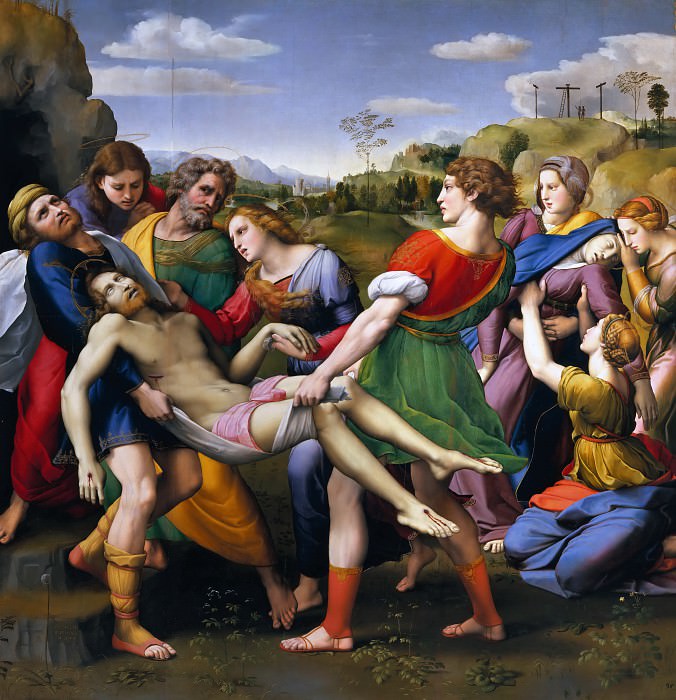Entombment Raphael (1483-1520)
Raphael – Entombment
Edit attribution
Download full size: 4055×4200 px (4,4 Mb)
Painter: Raphael
Location: Borghese gallery, Rome (Galleria Borghese).
Raphael often happened to refer to Christian subjects. In reinterpreting them, he sometimes altered them so that they changed slightly, becoming livelier and fuller. "The Position in the Coffin" depicts the moment when the body of Christ, taken down from the cross, was carried to be buried by his family and friends. Holding him on a stretched cloth, they carry him into the gardens, to where a wealthy man has provided his own private tomb for burial. Christ’s body is lifeless.
A description of Raphael Santi’s painting The Posing of the Coffin
Raphael often happened to refer to Christian subjects. In reinterpreting them, he sometimes altered them so that they changed slightly, becoming livelier and fuller.
"The Position in the Coffin" depicts the moment when the body of Christ, taken down from the cross, was carried to be buried by his family and friends. Holding him on a stretched cloth, they carry him into the gardens, to where a wealthy man has provided his own private tomb for burial.
Christ’s body is lifeless. His hands and feet have bloody nail marks, his head is tilted back, his eyes are closed. The body hangs in a way a living person cannot - relaxed and yet very soft, like a sack of flour, not flesh and bone. It is carried by the disciples, supported, pulled. Their faces are sorrowful, the youngest reaches for Christ, as if wanting to touch him and not believing that he could die. None of them believes, but the body in their hands is the best proof of death.
Behind the men carrying the body go the women. Mary was walking among them, but in the picture she faints, stumbles, and is caught and supported by caring, sympathetic hands. Mary Magdalene, kneeling, not believing in death and grieving for the dead, reaches out to catch the Virgin and her very pose expresses confusion and horror. The others are calmer, holding themselves better, and somewhere far away, above the procession - awkward, mournful, afraid of the cause for which they have gathered - rise the crosses on the bald Golgotha, which is forever destined to remain in human memory as the place where God was crucified.
Raphael gives the scene a sad vitality, creating something that is intuitive to understand. At a glance one can see the sorrow and confusion of the disciples, the Virgin’s face expresses mortal agony, as if she were crucified with her son, as if all his pain were hers.
Using mercilessly bright colors, Raphael shows how frightening it is that the world continued to be, and continued to be without fading in the slightest, without becoming less festive.
God died, and no one but his disciples noticed it.
Кому понравилось
Пожалуйста, подождите
На эту операцию может потребоваться несколько секунд.
Информация появится в новом окне,
если открытие новых окон не запрещено в настройках вашего браузера.
You need to login
Для работы с коллекциями – пожалуйста, войдите в аккаунт (open in new window).




















You cannot comment Why?
In the background, the landscape opens up to rolling hills and a distant cityscape. In the far background, three crosses stand silhouetted against the sky, a stark reminder of the crucifixion. The overall mood is one of profound grief and solemnity.
The subtexts of the painting are rich and layered. The central theme is the sacrifice of Christ and the immense sorrow it causes. The painting highlights the physical and emotional toll of his death, particularly on his mother, Mary, and his devoted followers. The composition, with its diagonal lines and crowded figures, creates a sense of turmoil and struggle, emphasizing the weight of the moment. The presence of the three crosses in the distance reinforces the story of Christs passion and the Christian narrative of death and resurrection. The differing emotional responses of the figures – from swooning grief to desperate holding – suggest the individual impact of Christs death on those who loved him. The vibrant colors, typical of High Renaissance art, contrast with the somber subject matter, adding a sense of divine beauty even in tragedy.